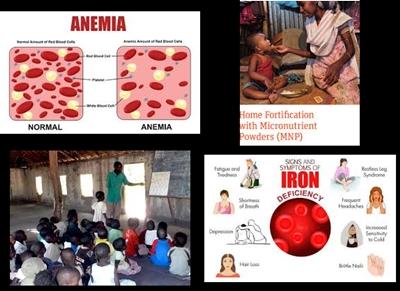
Objectives:
Approximately 600 million children of preschool and school age are anaemic worldwide. It is estimated that at least half of the cases are due to iron deficiency. Point-of-use fortification of foods with micronutrient powders (MNP) has been proposed as a feasible intervention to prevent and treat anaemia. It refers to the addition of iron alone or in combination with other vitamins and minerals in powder form, to energy-containing foods (excluding beverages) at home or in any other place where meals are to be consumed. MNPs can be added to foods either during or after cooking or immediately before consumption without the explicit purpose of improving the flavour or colour. Therefore, this review article (meta-analysis) has been conducted.
The aim of this review article is to assess the effects of point-of-use fortification of foods with iron-containing MNP alone, or in combination with other vitamins and minerals on nutrition, health and development among children at preschool (24 to 59 months) and school (5 to 12 years) age, compared with no intervention, a placebo or iron-containing supplements.
Study design:
This review article included 13 trials (RCTs and quasi-RCTs) involving 5,810 participants from Latin America, Africa and Asia, of which 6 ongoing/unpublished trials.
All trials compared the provision of MNP for point-of-use fortification with no intervention or placebo. No trials compared the effects of MNP versus iron-containing supplements (as drops, tablets or syrup).
The sample sizes in the included trials ranged from 90 to 2193 participants. 6 trials included participants younger than 59 months of age only, 4 included only children aged 60 months or older and 3 trials included children both younger and older than 59 months of age.
The iron doses varied from 2.5 mg to 30 mg of elemental iron. 4 trials reported giving 10 mg of elemental iron as sodium iron ethylenediaminetetraacetic acid (NaFeEDTA), chelated ferrous sulphate or microencapsulated ferrous fumarate. 3 trials gave 12.5 mg of elemental iron as microencapsulated ferrous fumarate. 3 trials gave 2.5 mg or 2.86 mg of elemental iron as NaFeEDTA. 1 trial gave 30 mg and 1 trial provided 14 mg of elemental iron as microencapsulated ferrous fumarate, while 1 trial gave 28 mg of iron as ferrous glycine phosphate.
Micronutrient powders contained from 2 to 18 vitamins and minerals
Results and conclusions:
The investigators found in comparison with receiving no intervention or a placebo, children receiving iron-containing micronutrient powders for point-of-use fortification of foods had a significantly lower risk of 34% for anaemia prevalence [prevalence ratio = 0.66, 95% CI = 0.49 to 0.88, 10 trials, 2,448 children; moderate-quality evidence].
The investigators found in comparison with receiving no intervention or a placebo, children receiving iron-containing micronutrient powders for point-of-use fortification of foods had a significantly lower risk of 65% for iron deficiency [prevalence ratio = 0.35, 95% CI = 0.27 to 0.47, 5 trials, 1,364 children; moderate-quality evidence].
The investigators found in comparison with receiving no intervention or a placebo, children receiving iron-containing micronutrient powders for point-of-use fortification of foods had higher haemoglobin levels [mean difference MD = 3.37 g/L, 95% CI = 0.94 to 5.80, 11 trials, 2,746 children; low-quality evidence].
The investigators found in comparison with receiving no intervention or a placebo, no effect on diarrhoea among children receiving iron-containing micronutrient powders for point-of-use fortification of foods was observed [risk ratio = 0.97, 95% CI = 0.53 to 1.78, 2 trials, 366 children; low-quality evidence].
The investigators concluded point-of-use fortification of foods with micronutrient powders containing iron (2.5 mg to 30 mg of elemental iron) reduces anaemia and iron deficiency in preschool- and school-age children. However, information on mortality, morbidity, developmental outcomes and adverse effects is still scarce.
Original title:
Point-of-use fortification of foods with micronutrient powders containing iron in children of preschool and school-age by De-Regil LM, Jefferds MED and Peña-Rosas JP.
Link:
https://www.ncbi.nlm.nih.gov/pubmed/29168569
Additional information of El Mondo:
Find more information/studies on food fortification/malnutrition, study design/meta-analysis/significant and iron right here.